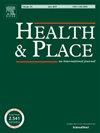The association of neighborhood walkability and food environment with incident cardiovascular disease in The Maastricht Study
IF 3.8
2区 医学
Q1 PUBLIC, ENVIRONMENTAL & OCCUPATIONAL HEALTH
引用次数: 0
Abstract
Built environmental determinants can drive lifestyle behaviors and potentially reduce chronic disease prevalence. Few studies exist that have examined the association of obesogenic environment exposures with cardiovascular disease (CVD) outcomes. We aim to specifically examine the association between neighborhood walkability, food environment and CVD. Data from 6117 Dutch participants of The Maastricht Study, between the ages of 40 and 75 years in the Netherlands were examined. Home addresses were linked to geographic information systems data from the Geoscience and Health Cohort Consortium to create neighborhood exposures of walkability and food environment. Perceived walkability was obtained from the Abbreviated Neighborhood Environment Walkability Scale. An 11-year incidence of CVD was defined by self-reported non-fatal or fatal event (as registered by Statistics Netherlands). Cox regression models examined the association of environment exposures with incident CVD adjusted for demographic and socioeconomic variables. There was lower incidence of CVD using the perceived walkability questionnaire in those living in the most walkable neighborhood (Quartile 4 HR: .77; 95% CI = .62, .97) but not using the objective walkability index (Quartile 4 HR: 1.10; 95% CI = .89, 1.38). There was no association between the food environment and incident CVD (Quartile 4 HR: .82; 95% CI = .65, 1.04). The discordant findings between walkability measures suggest integrating residential feedback and accounting for lived experiences should be prioritized by policymakers when designing equitable neighborhoods to prevent CVD.
马斯特里赫特研究中社区步行和食物环境与心血管疾病的关系
建成的环境决定因素可以驱动生活方式行为,并可能降低慢性疾病的患病率。很少有研究调查肥胖环境暴露与心血管疾病(CVD)结果的关系。我们的目的是专门研究邻里步行,食物环境和心血管疾病之间的关系。研究人员对6117名年龄在40岁到75岁之间的荷兰人进行了调查。家庭住址与来自地球科学和健康队列联盟的地理信息系统数据相关联,以创建可步行性和食物环境的社区暴露。感知步行性采用简易邻里环境步行性量表。11年的CVD发生率由自我报告的非致命性或致命性事件定义(荷兰统计局登记)。Cox回归模型检验了环境暴露与心血管疾病事件之间的关系,调整了人口统计学和社会经济变量。使用感知步行能力问卷的居住在最适宜步行社区的人心血管疾病发病率较低(四分位数HR: 0.77;95% CI = 0.62, 0.97),但未使用客观步行指数(四分位数4 HR: 1.10;95% ci = 0.89, 1.38)。食物环境与CVD事件之间没有关联(四分位数HR: 0.82;95% ci = 0.65, 1.04)。可步行性测量之间的不一致结果表明,在设计公平的社区以预防心血管疾病时,政策制定者应优先考虑整合居民反馈和考虑生活经验。
本文章由计算机程序翻译,如有差异,请以英文原文为准。
求助全文
约1分钟内获得全文
求助全文
来源期刊

Health & Place
PUBLIC, ENVIRONMENTAL & OCCUPATIONAL HEALTH-
CiteScore
7.70
自引率
6.20%
发文量
176
审稿时长
29 days
期刊介绍:
he journal is an interdisciplinary journal dedicated to the study of all aspects of health and health care in which place or location matters.
 求助内容:
求助内容: 应助结果提醒方式:
应助结果提醒方式:


